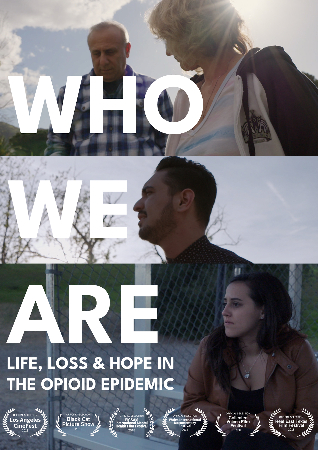
Who We Are: Life, Loss & Hope in the Opioid Epidemic 2018
Distributed by epf media, 324 S. Beverly Drive, PMB 437, Beverly Hills, CA 90212; 310-839-1500
Produced by Julia Davis and Monica Johnson Harris
Directed by Nicholas Manting Brewer
Streaming, 27 mins
Middle School - General Adult
Death; Drug Abuse; Grief
Date Entered: 02/28/2022
Reviewed by Shanna Hollich, Director, Guthrie Memorial Library - Hanover's Public LibraryWho We Are is a short and beautiful film that focuses primarily on the grief of the Isaac family as they mourn the loss of their son, Josh, to what the viewer can only assume was an opioid overdose. The opening scenes are poetic and stunning. We learn that every day in the US, 91 people die of opioid overdoses, which includes prescription painkillers and heroin. One by one, we’re then introduced to Josh’s parents and his sister as they look through family photos and remember their loved one, interspersed with clips from home movie footage that shows Josh as a young boy.
The main point of the film becomes clear from the outset, then: humanizing people who die of opioid overdoses in a world where the media so often stereotypes and vilifies them. However, that’s as far as the film goes. There is no narrative structure and no context for any of the people we meet in the film beyond their name and title cards. For example, we meet Pat Montoya, introduced as a community activist and President of Not One More, but the film never makes clear what Not One More is or does, or why Mr. Montoya is included in the film. Similarly, we get glimpses of other people - a former caregiver, a former opioid addict - in brief vignettes, but their importance to the overarching story or themes presented in the film as a whole is never made explicit.
Ultimately, this film is all flash but little substance. Perhaps more troubling is its focus primarily on white families, despite the fact that the opioid epidemic affects families of all races and ethnicities. The devastating losses faced by these communities are not all the same, and it would have made for a more interesting film to highlight the impacts of class, culture, and socioeconomic status on drug abuse.
This film does an excellent job at what I infer to be its primary purpose: putting a human face on the loss and grief experienced by those left behind after a drug-related death. I recommend this film with reservations: it would be a good addition to film studies, or even to a journalistic writing or nonfiction storytelling program, as it approaches its subject in a novel way. It is not, however, a film with reliable and authoritative facts and figures on the opioid crisis, which some viewers may assume based on the subject matter and would therefore likely not be useful in more fact-based subject areas. Those interested in fields such as psychology, health sciences, or criminal justice may find it compelling to see this glimpse into the real lives of the people they are potentially working with; while the film wouldn’t give them facts and figures they can use to inform their policies and practices, it could help instill a greater sense of empathy and compassion in their work.
Published and licensed under the Creative Commons Attribution 4.0 license. Anyone can use these reviews, so long as they comply with the terms of the license.